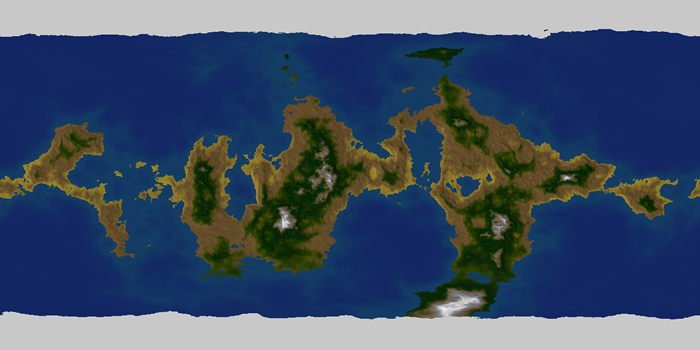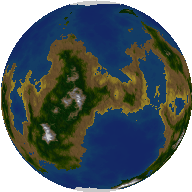Table of Contents
Otâgolisoy (Birth world)
The birth world of the people who would come to be known as the Poku Saeruo Degonjo is known as Otâgolisoy. It was a world of jungles and velds. More than seven hundred years ago, this planet was destroyed by an ancient enemy.
History
Pre-History
Great jungles spread across the northern regions and it was here that
The Qaktoro developed in the vast jungles spreading out across the northern regions of the planet. They developed tribally as they achieved sentience, and individual tribes claimed hunting and foraging grounds and protected them fiercely. In time, these tribes joined together to form larger groups which they called houses. Multiple houses joined to form nations. Gradually, the Qaktoro became less migratory and tribal, and they continued to develop technology and new weapons with which to battle each other. Wars between houses became common, and so prudent houses joined to form clans; consolidation meant survival, isolation meant death.
To the south, where velds spread across the horizon, the Tula developed their own distinct culture. These smaller cousins of the Qaktoro learned to work together in a cooperative, agrarian culture. The Tula developed new and better ways to grow crops, and later they used plant breeding techniques to create new varieties of plants. They created hybrid breeds, and even learned how to perform horticultural grafts. Crops were used to create medicines, clothing and a wide variety of other important items that aided their society's development. Plants that were important to the Tula then, and today, include the Jodauvit (Think Plant) and the Vithuos (Life Tree).
A major shift in weather patterns led to a massive drought that impacted the northern Qaktoro. In their building of villages and their wars of aggression with each other, had deforested large portions of their jungle. The drought wreaked havoc on their ability to hunt and survive, and this pushed them to explore even more distant regions of their planet. When they reached the southern velds, they encountered the smaller Tula for the first time. While the initial contact was friendly, it was not long before the leaders of the Qaktoro saw the Tula as weak, and as rivals for resources. The Qaktoro launched a long and bloody campaign of near-genocide against the Tula. It was only thanks to the ancient predecessors of the modern Detis Goa'ai Jael (Faith Walkers Sect) and the Otâmovi Wiy Jael (Silver Moon Sect) that the genocide was averted before its bloody and final conclusion. These two groups of Qaktoro thinkers had seen that the Tula possessed unique skills and abilities, and they convinced the Qaktoro leaders to end the slaughter and subjugate the Tula, rather than kill them all entirely. It was in these circumstances that the Tula were subsumed into the now-dominant Qaktoro culture as a subordinate species.
Industrial Age
The Industrial Age of the Qaktoro saw Otâgolisoy suffer significant environmental damage. The drought and deforestation had already begun harming the world's ecosystem, but pollution and tree-harvesting and strip-mining techniques only worsened the world's health. As a number of native species populations began to tragically die off, the Qaktoro society managed to reverse course. Both Qaktoro and Tula started exploring new methods of production to move beyond the early industrial age without continuing to ravage their own world. They constantly worked to find a balance between the needs for industry, resources, and habitats for their people.
Era of Space Flight
By the time that they had developed crude space travel, the home world was a carefully maintained ecosystem. Further improvements were made when they moved most of their industrial facilities into orbital stations and onto the planet's moon. The denizens of Otâgolisoy took to space purely out of a need to find new resources. They sent remote probes to explore nearby star systems knowing it would be years before they heard back from them. These probes returned after fifty year journeys, their memory filled with data of life-supporting worlds and abundant resources. The first Tinvyma Movidoanor (Tunnel Drive)-equipped craft were sent out to these worlds; this marked the beginning of a major move of the Qaktoro and Tula away from Otâgolisoy.
The Poku'ka Qaktoro (Qaktoro Empire)
In time, colonies were formed on worlds within reach of Otâgolisoy, and the space-faring felinoids encountered other sentient species and formed alliances with them. So empowered, the Qaktoro established a Poku'ka Qaktoro (Qaktoro Empire), reaching a wide-spreading population of 12 billion at their height. In time, their alliances caused the Poku'ka Qaktoro to be drawn into battle with a tremendously powerful enemy. Allies of the Qaktoro Empire provoked a war by attacking a species that the Qaktoro called Ryasou'temygo (Death Wraiths). In an extended and brutal series of engagements over the course of years, the Qaktoro Empire and its allies crumbled world by world until they were sure that they were facing their own certain extinction.
The Norka
At this point, the events preceding the Norka took place. You can read more about these events here, where you can also find an account of the destruction of Otâgolisoy at the hands of the Qaktoro Empire's ancient foe.
Description
Otâgolisoy was a terrestrial world with 63 percent of the surface covered by oceans. While the planet had a diverse ecosystem, there were two dominant terrain types; jungles and velds. The largest continent that the Poku Saeruo Degonjo races began on was divided by a massive mountain range. The planet orbited a G series star whose orbital period was 352 days, and the planetary rotation was 30 hours. The planet possessed abundant surface resources and mineral resources. It had a gravity of 1.1 G.
Otâgolisoy had one orbiting moon, as well as a ring of ice and gases.

